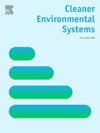Meta-analysis of yield-emission trade-off in direct seeded vs. puddled transplanted rice: Towards a cleaner and sustainable production
IF 6.1
Q2 ENGINEERING, ENVIRONMENTAL
引用次数: 0
Abstract
Conventional rice production through puddled transplanted rice-PTR is tillage, water, energy, and capital intensive. Furthermore, it is a major contributor to greenhouse gas (GHGs) emissions. In this regard, Direct seeded rice-DSR can be a potential alternative to PTR for reducing GHGs emissions, while sustaining yields. However, depending upon agroclimatic situation, whether the effect of DSR on GHGs emission and yield are consistent or not, as compared to PTR need a comprehensive analysis. To bridge this knowledge gap, we performed a meta-analysis synthesizing 876 paired measurements from 54-peer-reviewed studies to understand how DSR impacts N2O and CH4 emissions, global warming potential-GWP (heat-trapping potential of greenhouse gases compared to CO2), yield and C-footprint-CFP (environmental impact in CO2 eq. due to concerned activity). Compared to PTR, DSR decreased CH4 emissions by 70%, GWP by 37% and CFP by 34%, despite 85% increase in N2O emissions. However, this shift comes with 11% decrease in yield. To decipher the primary factors driving these outcomes, we conducted subgroup analyses by taking environmental conditions and management practices as predictors in a random effect model. Low to medium pH soils, zero tillage, puddled soil (wet DSR), conventional flooding, and high nitrogen rates (>200 kg/ha) are found to be favorable for DSR with comparable yields but posing a discrepancy with environmental sustainability benefits. Therefore, further research to evaluate DSR across agro-ecologies, management practices are needed to optimize yields with lower GWP and CFP.
直接播种与水坑插秧水稻产量-排放权衡的meta分析:走向更清洁和可持续的生产
通过水坑移栽水稻(ptr)进行的传统水稻生产是耕作、水、能源和资本密集型的。此外,它还是温室气体(ghg)排放的主要来源。在这方面,直接播种稻- dsr可以作为PTR的潜在替代品,在减少温室气体排放的同时保持产量。然而,根据不同的农业气候情况,DSR对温室气体排放和产量的影响与PTR相比是否一致,需要综合分析。为了弥补这一知识差距,我们进行了一项综合了54项同行评议研究中876个配对测量值的元分析,以了解DSR如何影响N2O和CH4排放、全球变暖潜势- gwp(与二氧化碳相比温室气体的吸热潜势)、产量和碳足迹- cfp(相关活动对二氧化碳当量的环境影响)。与PTR相比,DSR减少了70%的CH4排放量,37%的GWP和34%的CFP,尽管N2O排放量增加了85%。然而,这一转变伴随着11%的收益率下降。为了解释驱动这些结果的主要因素,我们将环境条件和管理实践作为随机效应模型的预测因素,进行了亚组分析。研究发现,低至中等pH值土壤、免耕、水坑土壤(湿DSR)、常规淹水和高施氮量(200公斤/公顷)有利于DSR,产量相当,但与环境可持续性效益存在差异。因此,在较低的GWP和CFP条件下,需要进一步开展跨农业生态系统的DSR评估研究和管理实践,以优化产量。
本文章由计算机程序翻译,如有差异,请以英文原文为准。
求助全文
约1分钟内获得全文
求助全文
来源期刊

Cleaner Environmental Systems
Environmental Science-Environmental Science (miscellaneous)
CiteScore
7.80
自引率
0.00%
发文量
32
审稿时长
52 days
 求助内容:
求助内容: 应助结果提醒方式:
应助结果提醒方式:


